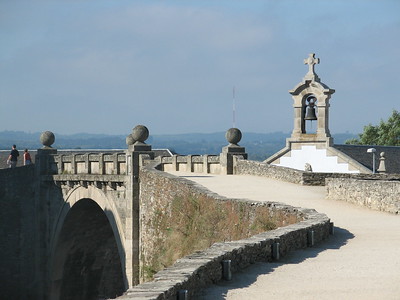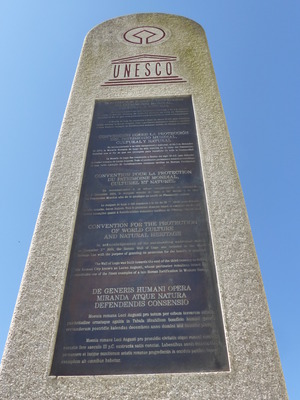Roman Walls of Lugo

The Roman Walls of Lugo are the only complete and intact urban defensive walls surviving anywhere in the former Roman Empire.
Their circumference is 2,117m and the height varies between 8 and 10m. The width of over 4m provides space for a walkway along the top of the walls. Five of the original gates and numerous interval towers are still intact. Lugo, called Lucus Augusti by the Romans, was a regionally important colonial town. The walls were constructed in the 3rd and 4th centuries CE.
Community Perspective: You can do a full loop of the walls by walking on the ramparts. In town, there is the Centro de Interpretación da Muralla de Lugo in Praza do Campo which gives detailed information on the walls' importance.


Map of Roman Walls of Lugo
Community Reviews
J. Stevens

During my visit of Galicia in August 2022, I spent one day in Lugo to explore the town and its two WHS: the Roman walls and its cathedral.
I went there by car, drove under one of the gates and parked within the Roman walls. I first went for a stroll to get a feel of the town and to visit the tourist office, that also offers an interpretation centre for the Walls. Unfortunately, it’s only in Spanish, so I whizzed through looking at some of the pictures about the construction of the wall.
I went for a small walk around the outside of the wall and then did the whole tour of the town on top of the walls starting at the ramp in front of the cathedral, where you will also find a stele with the Unesco symbol. The wall doesn’t offer many places with shade, so a walk on the walls maybe wasn’t the best idea when the sun is at its highest and hottest, but it gave me something to do during the time most of the other sites were closed because of the siesta. There are nice views over the historic centre, but you also have parts where you just see less attractive backs of houses.
To get a better understanding of the Roman history of Lugo, or “Lucus Augusti” as it was called in those days, I visited the Provincial Museum, which has some Roman mosaics and other objects from the Roman period. There is the University Museum “A Domus do Mitreo”, where you can see the rests of a Roman house with a Mithraeum. On the Rúa Doutor Castro, there is the “Casa dos Mosaicos”, where you can still see Roman mosaics in situ. A short video, only in Spanish, tells the story of the house. The person in charge was very friendly and explained the different parts of the house to me in English. Parts of the street also have glass tiles that show the mosaics that lie under it.The exposition hall just outside the Porta Miñá also housed an exposition on the Roman history of Lugo, completed with a video of how the town evolved from Roman times to today.
The Provincial Museum, the “Casa dos Mosaicos” and the Porta Miñá expositio hall were free and I feel they completed the picture of the Roman history of Lugo, of which the Walls form an important part.
Jay T

The Romans left a mark on northwestern Spain that can still be seen today in bridges, ancient villages, gold mines, a lighthouse, and, most spectacularly, the Roman Walls of Lugo. I visited the latter when hiking parts of the Camino Primitivo in May 2019. This is one of two World Heritage Sites I visited on that trip to Spain that were famed for their walls (the other, Avila), and I have to say I preferred these walls. I circumnavigated Lugo twice, once following the perimeter at ground level, and once on the ramparts. Both trips gave a good perspective of the walls' height and width, which really must be seen to be appreciated. In the evening, quite a lot of locals come out for exercise jogging or walking around the walls. There's really not a lot more to say about this site -- the walls are remarkably intact and they so far have stood the test of time.
The history of Lugo, however, gave me a greater appreciation for how this corner of the Roman empire fits into world history. Lugo was likely originally named after the Celtic god Lugus, since Gallaecia, now known as Galicia, was home to the Gaels who settled Ireland (and, in fact, you can still hear bagpipes played in Galicia). The town was renamed Lucus Augusti when the Romans came to Galicia to mine gold for use in jewelry, art, and coins. The town became the most important for the Romans in Galicia, and in the 3rd century the Romans constructed the walls around Lugo not just to protect against outsiders, but also against local tribesmen unhappy with the Romans. They ultimately failed, as the Romans were defeated in the fifth century. Over time Lugo became a stop on the original pilgrimage route to Santiago de Compostela, and it still gets visits today from both pilgrims and enthusiasts of Roman architecture. The walls are certainly worth a visit if you find yourself in northwest Spain.
Logistics: The Roman Walls of Lugo are quite easy to access and traverse on foot.
Clyde

I visited this WHS in June 2016. I walked the whole loop on the walls as well as round the walls from beneath. The Roman walls are really huge, 4m thick and varying between 8 to 12m high. There are 88 towers and 10 gates, 5 dating back to the Romans and the rest added in the 19th century as the population increased. Up until quite recently there were sections of the outer walls to which houses were attached but these have been removed. A visit to the Centro de Interpretación da Muralla de Lugo in Praza do Campo helps to give detailed information on the walls' importance. The only tower with two arches hints to what the towers must have been like in Roman times. Next to the Santiago Gate is a white vertical slab with the UNESCO plaque. The Camino Primitivo and the Camino de Invierno both start or pass through Lugo. I enjoyed my stay in Lugo and I'm glad I stayed for 1 night within the walls. That way I could enjoy Lugo's everyday life from different viewpoints on the walls: from school children playing at lunchtime, people jogging, sunrise, sunset and the walls lit at night.
Ian Cade

I had a lovely morning strolling along the circuit of walls watching banks of fog roll in and then burn off in the early autumn sun. Like, Els I also encountered lots of joggers, and must admit to being a touch envious that they had such a lovely route to run. The walls can at times be quite high, and it was interesting looking down on the everyday life happening around them much as it has done for the close to 2,00 years since their initial building. It reminded me a little of the Roman castle at Portchester where I grew up, but the walls in Lugo were much larger.
I did spend a little bit of time walking around the town itself which was quite pleasant; the cathedral is evidently based on its much grander cousin in Santiago. Lugo was bi-passed by the main pilgrimage route west (Camino Frances) but features on the earlier Camino Pimativo reflecting the towns age. I had intended to stay a night in Lugo however the draw of the Camino was too strong and I headed off comfortable that I had seen all I wanted to in the 2.5 hours I was in the city.
The walls are very impressive, and their age even more so, there are no towns in Europe that are encircled by a set of defences of this vintage, and as such it is well worth its place on the list and worthy of at least one circuit of its walls.
[Rating: Site 5; Experience 4]
John booth

When I arrived in Lugo there were Roman legions parading around the Praza Maior and crowds of people dressed in togas were feasting and imbibing at various stalls. But I would imagine that when not in fiesta mode it is fairly ordinary.
But the town's walls are extraordinary for their thickness, elaborate archways and the continuous walkway around the top.
Els Slots

The city of Lugo is located in Galicia, on the route to Santiago de Compostela. I encountered a few pilgrimage cyclists on the way, but no hikers. Lugo's WHS status is for having the only Roman city walls that are both intact (i.e. authentic enough) and entirely complete. In this, they beat the similar ones in Carcassonne, Avila and Le Mans (according to the ICOMOS evaluation at inscription).
My goal for the day was to walk the entire circuit (2km). I accessed the ramparts from the Rua do Teatro. The most amazing thing, at first sight, is how broad this wall is! Four to seven meters wide apparently. It's just like a major road. The only comparison that directly came to my mind is the City Wall of Xi'an in China (it is newer, 14th century, but even wider). If I remember well, they even allow cyclists there.
It's a very fine stroll. It goes up and down slightly, the heights of the wall very between 8 and 12 m. You also get a good look at the city from all sides, although it's a kind of 'railway view' (in plain sight are not the best of houses). I encountered lots of joggers on my walk, some even twice. For a good exercise one has to round the circuit several times.
The entire walk took me about half an hour including photo stops. A quick site to visit! I didn't venture into the city center of Lugo, but made my way north to other Roman remains instead: the Torre de Hercules in A Coruna.
The Roman Walls themselves are enormous and well preserved, you can walk around the city on top of the wall (2,5km). Actually they walls are so huge that they would fit a dual carriageway. If the walls wouldn't be there there aren't many reasons to visit Lugo.
Community Rating
- : Inigo Cia Alexander Lehmann Juropa Persian Globetrotter
- : Cezar Grozavu Antonio J.
- : GeorgeIng61 Luisfreire Voyager Joyce van Soest George Gdanski Jezza Tarquinio_Superbo Thibault Magnien Fabi-ddorf Aspasia Ludvan Rvieira
- : Christravelblog CugelVance Javier MH
- : Zoë Sheng Craig Harder Walter Xiquinho Silva Patphilly Lichia Jxrocky Jay T Argo Miguel Marquez Emvcaest
- : Stanislaw Warwas Solivagant Chessjsr Wojciech Fedoruk Randi Thomsen Philipp Leu Nan Clyde David Berlanda Dorejd Philipp Peterer Daniel C-Hazard Shandos Cleaver Little Lauren Travels Shijie ZHU J. Stevens Aidan Coohill Alikander99 Kevin247 CeeMon João Aender Ivan Rucek Remigiusz
- : Adrian Turtschi Stanimir Ian Cade Dimitrios Polychronopoulos Hubert AustralLights Vernon Prieto Els Slots
- : Svein Elias
- : Janis
Site Info
- Full Name
- The Roman Walls of Lugo
- Unesco ID
- 987
- Country
- Spain
- Inscribed
- 2000
- Type
- Cultural
- Criteria
-
4
- Categories
- Archaeological site - Ancient Rome
- Link
- By ID
Site History
2000 Inscribed
Site Links
Connections
The site has 14 connections
Constructions
Damaged
Geography
History
Timeline
Visiting conditions
WHS Hotspots
WHS on Other Lists
World Heritage Process
Visitors
229 Community Members have visited.
The Plaque
 (photo by Clyde)
(photo by Clyde)